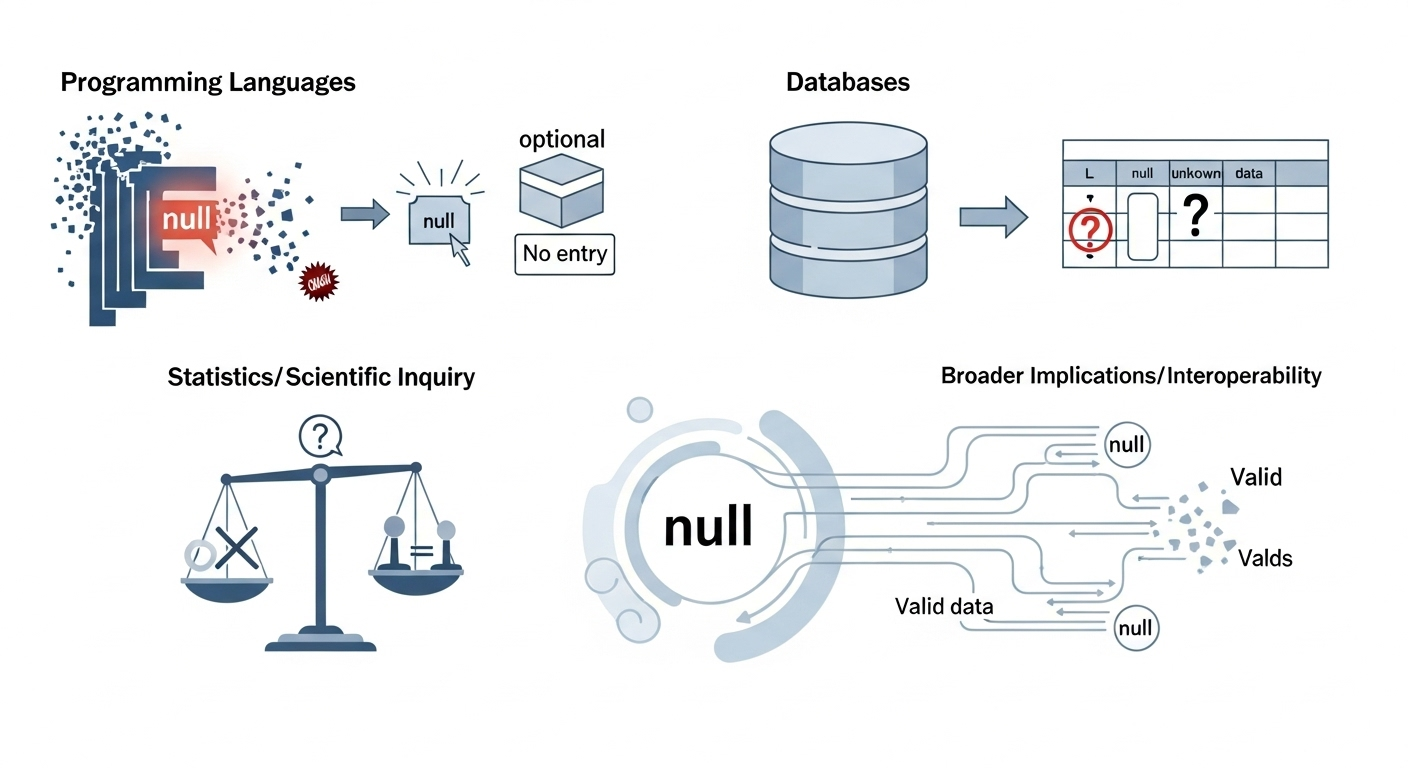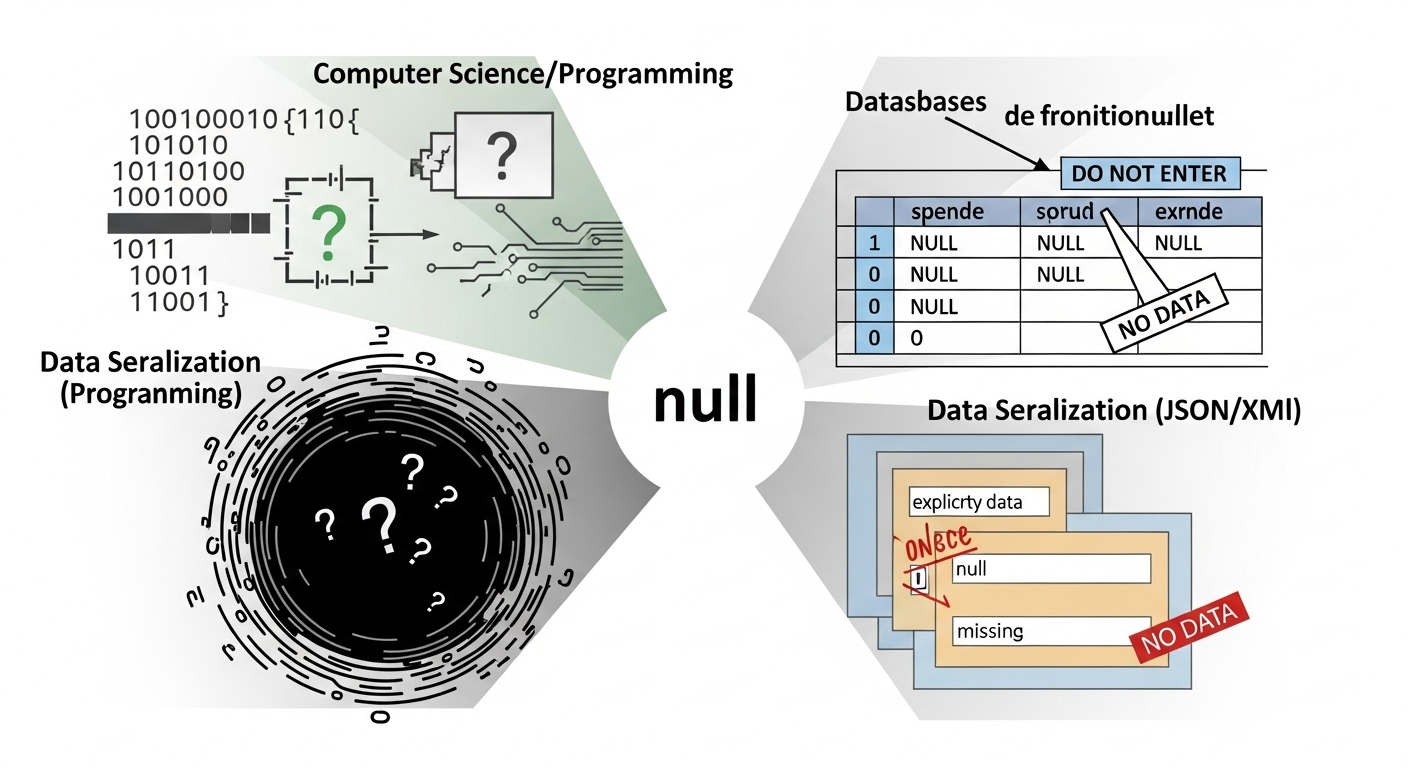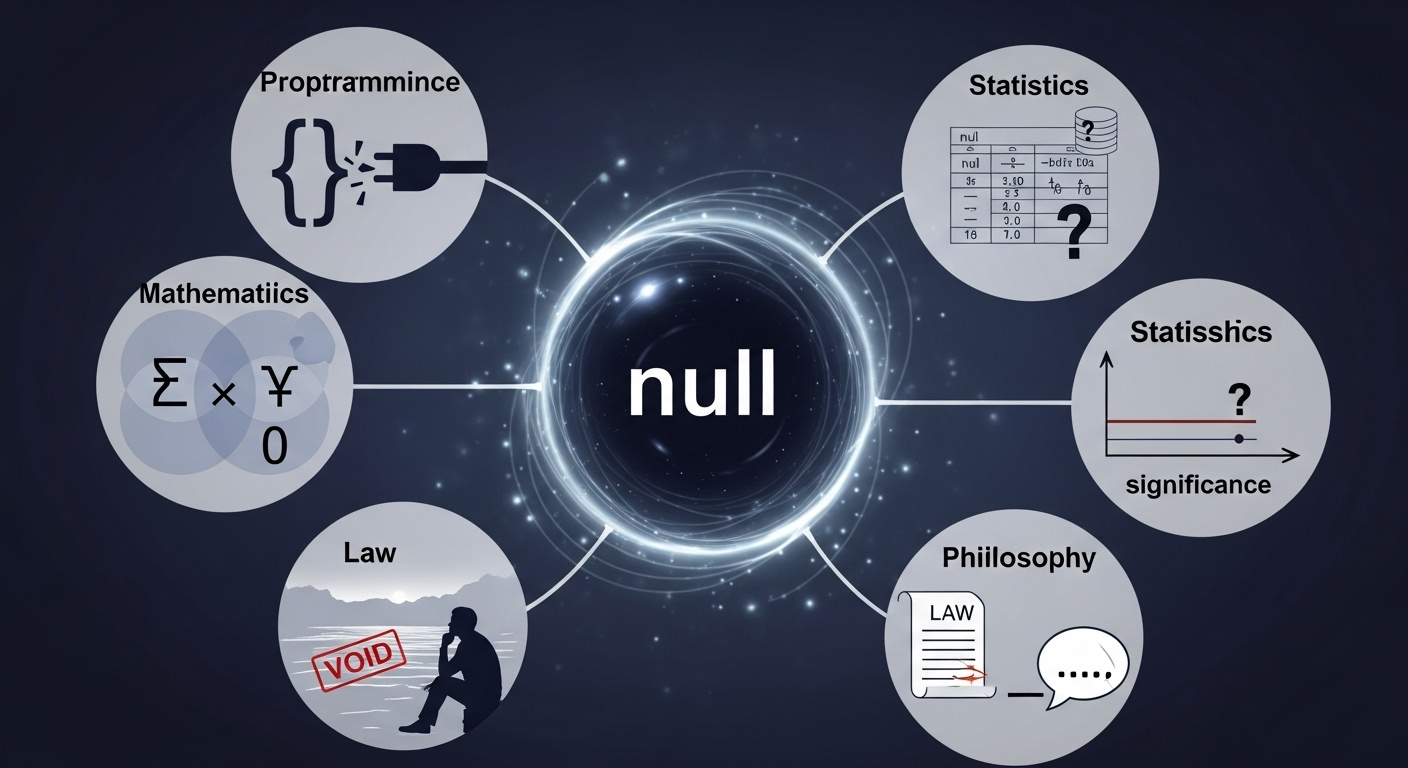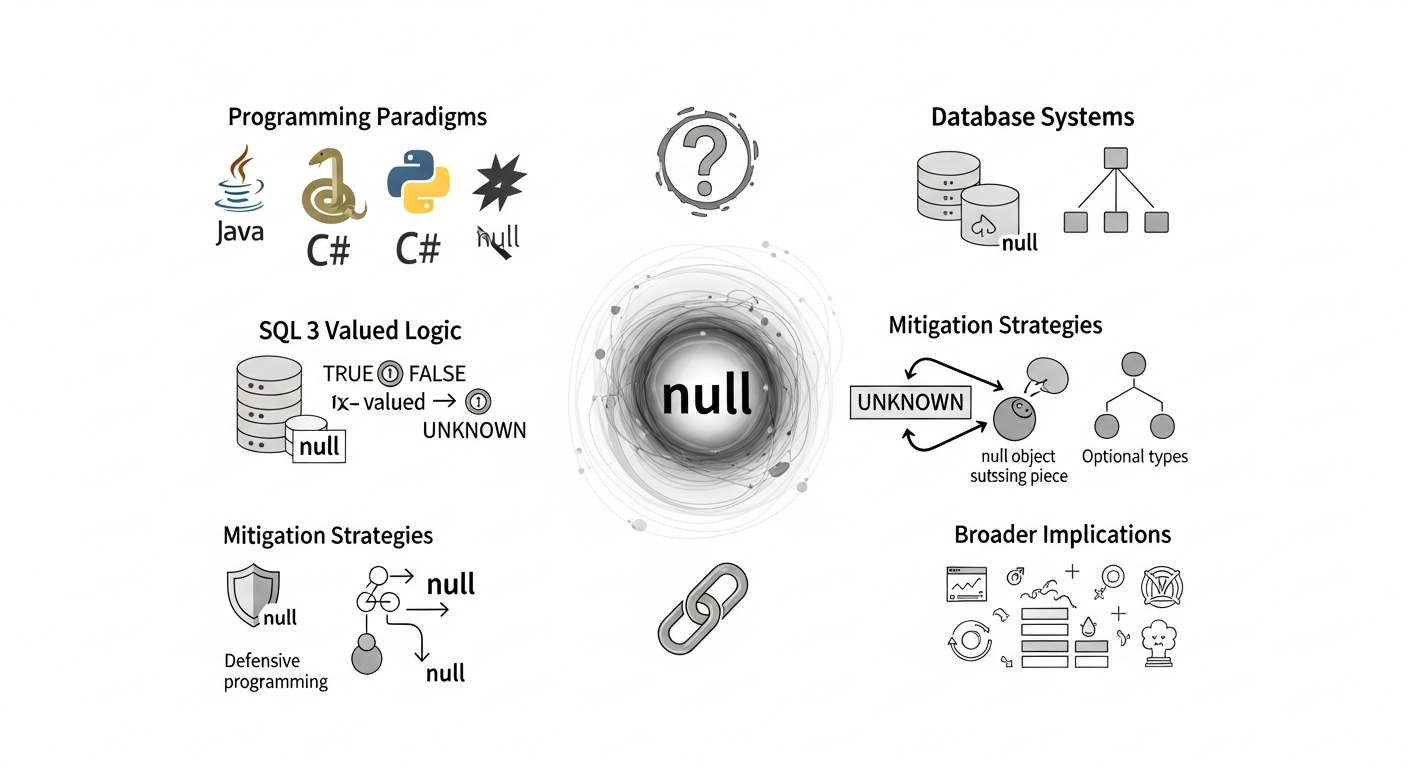The Ubiquitous Concept of Null: An In-Depth Examination Across Disciplines
The term "null" permeates various domains, from computer science to statistics, representing a concept often misunderstood yet critically important. Far from merely signifying "nothing," null carries specific implications and behaviors depending on its context, demanding a precise understanding for effective application.

Understanding the Core Concept of Null
At its most fundamental, null signifies the absence of a value or an unknown state. It is not equivalent to zero, which is a numerical value, nor an empty string, which is a sequence of characters with zero length. Instead, null operates as a distinct marker indicating that data is either missing, undefined, or explicitly not applicable. This distinction is crucial, as treating null as if it were a default value or an empty state can lead to significant logical errors and unexpected program behavior.
The ubiquity of the null concept stems from the need to represent incompleteness or uncertainty within structured systems. In an increasingly data-driven world, acknowledging and properly managing scenarios where information is absent is as important as managing the information that is present. The semantics of null, however, are not universal; they are shaped by the specific conventions and architectural philosophies of the system in which they are employed.
Null in Programming Languages: Challenges and Solutions
In the realm of computer programming, null often manifests as a null pointer or a null reference. This concept, famously coined the "billion-dollar mistake" by its inventor, Sir Tony Hoare, has been a perennial source of software bugs and vulnerabilities. A null pointer refers to a memory address that does not point to a valid object or memory location. Attempting to dereference a null pointer typically results in a runtime error, such as a NullPointerException in Java or C#, or a segmentation fault in C/C++.
Language-Specific Interpretations of Null
- Java, C#, C++: Explicit
nullkeyword used to represent a non-existent object reference or pointer. Managing null references requires careful checks to prevent runtime exceptions. The default value for object references in these languages, if not explicitly initialized, is often null. - Python: Uses
Noneto signify the absence of a value.Noneis a singleton object and behaves similarly tonullin other languages, representing a falsy value in boolean contexts. It is frequently used for uninitialized variables or as a default parameter for optional arguments. - JavaScript: Features both
nullandundefined. While both indicate an absence of value,undefinedtypically denotes a variable that has been declared but not assigned a value, a missing property in an object, or the return value of a function that doesn't explicitly return anything.null, conversely, is an assignment value that explicitly indicates "no value." Understanding this subtle difference is key for robust JavaScript development, especially when dealing with type checking and conditional logic. - Ruby: Employs
nil, which is an instance of theNilClass. Like Python'sNone,nilis an object that represents "nothing" and evaluates to false in a boolean context. It serves as the return value for methods that don't produce any meaningful result or for uninitialized instance variables.
Mitigating Null-Related Issues in Programming
The inherent danger of unchecked null references has spurred the development of various strategies and language features aimed at enhancing null safety. These approaches aim to either prevent null assignments where a value is expected or force developers to explicitly handle potential null values, thereby shifting error detection from runtime to compile time.
- Optional Types/Maybes: Languages like Swift (
Optional), Kotlin (nullable types with?), Haskell (Maybemonad), and Scala (Optiontype) introduce constructs that explicitly declare whether a value might be absent. This forces developers to unwrap or pattern-match these types, ensuring that the absence of a value (the null case) is handled at compile time, thus significantly reducing runtime errors and improving code predictability. - Annotations: In Java, annotations like
@Nullableand@NonNullcan be used by static analysis tools and IDEs to identify potential null pointer issues before compilation. While not enforced by the compiler itself, they provide valuable warnings and guidance to developers. - Defensive Programming: Explicitly checking for null before using a reference (e.g.,
if (myObject != null)) remains a common, albeit verbose, practice in languages without strong null safety features. This approach places the responsibility on the developer to anticipate and handle every potential null scenario. - Non-nullable by Default: Newer languages or language versions are increasingly adopting a "non-nullable by default" paradigm. This means variables and parameters cannot hold a null value unless explicitly declared otherwise, fundamentally altering the default assumption about value presence. This paradigm shifts the burden from preventing nulls to explicitly allowing and handling them, leading to more robust systems.
The ongoing evolution of programming paradigms continues to address the challenges posed by the concept of null, seeking to balance flexibility in data representation with robustness and reliability in software execution.
Null in Databases and Data Management: The SQL NULL
In relational databases, particularly those adhering to SQL standards, NULL serves a crucial role, albeit with its own set of unique characteristics and implications. SQL NULL represents missing or unknown data. It is neither an empty string nor a zero; it is a special marker that signifies the absence of an actual data value. This distinction is paramount for maintaining data integrity and for accurate query results, as its behavior deviates significantly from standard data types.
Characteristics and Behavior of SQL NULL
- Unknown Value Semantics: The primary interpretation of SQL NULL is "unknown." If a customer's email address is NULL, it means the database does not have a recorded email, not that the customer explicitly has no email or an empty email. It can also represent "not applicable" in certain contexts, where a column simply doesn't make sense for a particular row.
- Comparison Behavior: A critical and often perplexing aspect of SQL NULL is its behavior in comparisons. Any comparison involving NULL (e.g.,
column = NULL,column != NULL,column > NULL) will always evaluate to UNKNOWN, not TRUE or FALSE. This is because you cannot meaningfully compare an unknown value to anything else, including another unknown value (NULL is never equal to NULL in standard SQL comparisons). To check for NULL, one must use the specific predicatesIS NULLorIS NOT NULL, which explicitly test for the null state. - Three-Valued Logic (3VL): SQL incorporates a three-valued logic – TRUE, FALSE, and UNKNOWN – primarily due to the presence of NULL. This impacts how WHERE clauses and other conditional expressions are evaluated. For a row to be included in a result set, its WHERE clause must evaluate to TRUE. Rows where the condition evaluates to FALSE or UNKNOWN are excluded, which can lead to unexpected filtering if not carefully managed.
- Aggregate Functions: Most aggregate functions (e.g.,
COUNT(),SUM(),AVG(),MIN(),MAX()) typically ignore NULL values. For instance,COUNT(column_name)counts only non-null values in that column, whereasCOUNT(*)orCOUNT(1)counts all rows, including those with NULLs in specific columns. This behavior ensures that statistical calculations are based only on available, known data. - Constraints: Database schemas allow specifying whether columns can contain NULL values using
NULLorNOT NULLconstraints during table creation. ANOT NULLconstraint ensures that a column must always contain a value, thereby preventing the absence of data in critical fields. Unique constraints in SQL prevent duplicate non-null values; however, many database systems will allow multiple NULLs in a column that has a unique constraint, as each NULL is considered distinct (or unknown and thus not comparable to another unknown).
Impact on Data Integrity and Queries
Properly managing NULL values is vital for data quality, consistency, and the reliability of analytical results. Unintended NULLs can lead to inconsistencies across a dataset, incorrect aggregations, and erroneous join operations. For example, joining two tables on a column that contains NULLs might inadvertently exclude rows where the join key is NULL, if the join condition is not carefully constructed using IS NULL where appropriate. The implications extend to indexing and performance, as indexes on nullable columns can behave differently or be less effective.
In data warehousing and business intelligence, the handling of NULL values becomes even more complex. Decisions on how to impute missing data, how to explicitly represent nulls in reports, or how to filter them directly affect the insights derived from the data. The robust management and clear understanding of NULL semantics are therefore cornerstones of reliable data systems and accurate business reporting.
Null in Statistics and Scientific Inquiry: The Null Hypothesis
Beyond the digital constructs of programming and databases, the concept of null takes on a pivotal role in inferential statistics, forming the foundation of hypothesis testing. Here, the null hypothesis (often denoted as H₀) represents a statement of no effect, no difference, or no relationship between observed phenomena. It is the default position, assumed to be true until there is sufficient statistical evidence to suggest otherwise. This structured approach is fundamental to drawing objective conclusions from empirical data.
The Role of the Null Hypothesis in Research
In scientific research, hypothesis testing begins with formulating a null hypothesis alongside an alternative hypothesis (H₁ or Hₐ). The alternative hypothesis is what the researcher typically aims to demonstrate. The goal of statistical analysis is then to gather data and determine whether this data provides enough evidence to reject the null hypothesis in favor of the alternative. For instance, if testing the efficacy of a new medication, the null hypothesis might state that "the new drug has no effect on patient recovery time compared to a placebo." The alternative hypothesis would then be that "the new drug does have an effect (either positive or negative) on recovery time."
The Process of Hypothesis Testing with Null
- Formulate Hypotheses: Clearly define H₀ (the null hypothesis, representing no effect) and H₁ (the alternative hypothesis, representing an effect or difference).
- Collect Data: Gather relevant observations or experimental results through careful study design.
- Statistical Analysis: Perform appropriate statistical tests (e.g., t-tests, ANOVA, chi-squared tests) on the collected data to calculate a test statistic. This statistic quantifies how much the observed data deviates from what would be expected if the null hypothesis were true.
- Determine P-value: The p-value quantifies the probability of observing the data, or data more extreme, assuming the null hypothesis is true. A small p-value suggests that such an observation is unlikely if H₀ is correct.
- Decision:
- If the p-value is less than a predetermined significance level (alpha, typically 0.05), the null hypothesis is rejected. This suggests that the observed effect or difference is statistically significant and unlikely to have occurred by random chance alone.
- If the p-value is greater than alpha, there is insufficient evidence to reject the null hypothesis. This does not mean the null hypothesis is true, but rather that the data does not provide compelling statistical evidence against it at the chosen significance level.
It is crucial to understand that failing to reject the null hypothesis is not the same as proving the null hypothesis to be true. It simply means the study's data does not support the alternative hypothesis with sufficient statistical confidence. This nuance is central to interpreting scientific findings accurately and avoiding common statistical misinterpretations, which can have significant consequences in fields like medicine or social policy.
The concept of the null hypothesis provides a robust and standardized framework for drawing objective conclusions from data, enabling researchers to distinguish between random chance and genuine effects. It ensures a rigorous approach to scientific discovery, where claims must withstand critical statistical scrutiny against a baseline of no effect or no difference before being accepted.
The Broader Implications of Null
The multifaceted nature of null extends beyond these specific technical domains, influencing how data is exchanged, processed, and understood across various platforms and applications. Data serialization formats like JSON and XML frequently use null to represent missing or absent values, necessitating careful handling by parsers and consuming applications. In web services and APIs, a null field might indicate an optional parameter that was not provided, or a piece of information that simply does not exist for a given record or entity.
Challenges frequently arise when integrating systems that have different semantic interpretations of null. What one system considers an explicit "no value" (like SQL NULL), another might interpret as an empty string, a zero, or even omit the field entirely. These discrepancies can lead to data loss, integration failures, or incorrect data processing during transformations between systems. Establishing clear conventions and robust data governance policies regarding null is therefore essential for seamless interoperability and data consistency across complex, distributed ecosystems.
The historical debates surrounding null, particularly in programming, underscore its persistent and sometimes costly impact. Sir Tony Hoare's reflection on his "billion-dollar mistake" highlights the unforeseen complexities and expenses associated with a seemingly simple concept that allowed for undefined states. Modern language designs and architectural patterns are continually evolving to manage or eliminate the dangers associated with unhandled null states, aiming for safer, more predictable, and robust software systems.
The concept of null, while seemingly abstract, grounds many of our digital interactions and analytical processes. Its precise definition and meticulous management are not merely technical details but fundamental requirements for building reliable software, maintaining accurate data, and conducting sound scientific research across an ever-growing landscape of information.
Conclusion
The concept of null, explored across programming languages, database systems, and statistical methodologies, demonstrates a profound and pervasive impact on how information is structured, processed, and interpreted. It consistently represents the absence of a value, an unknown state, or a baseline condition, yet its specific behaviors and implications are profoundly context-dependent. A comprehensive understanding of null's nuances remains crucial for developing robust software, ensuring data integrity, and conducting rigorous scientific inquiry, underscoring its foundational role in modern information systems and analytical thought.










